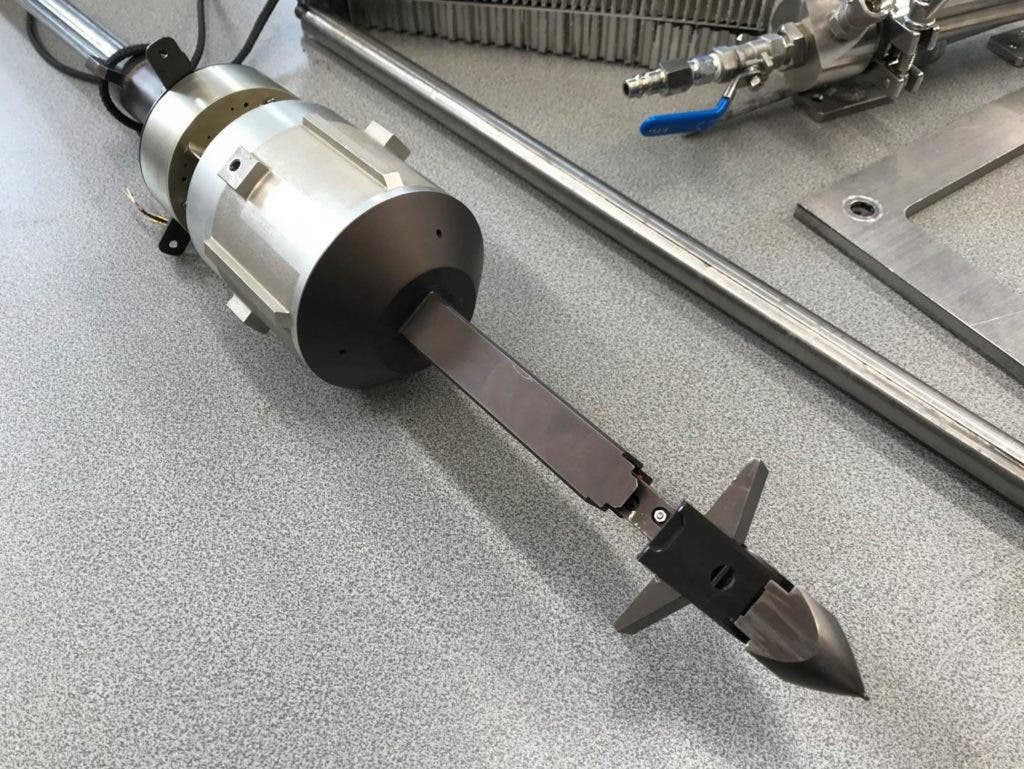
Airbus wants to hunt the biggest fish in space using a formidable harpoon it recently tested at one of its facilities in the UK, at the Surrey Space Centre. The harpoon is meant to grapple some of the biggest and most dangerous pieces of space junk like old rocket upper-stages or defunct satellites, which have been littering Earth’s orbit for decades.
The .9-meter-long (3 ft.) harpoon was fired using compressed air into a panel that mimics the kinds of material used to build satellite casings. These composite panels are mostly made of aluminum and are no more than 3cm-thick. During the tests, the harpoon punctured through the panel like a hot knife through butter, then immediately deployed a set of barbs that open up and stop the harpoon from falling out. In the live version, the harpoon will be tethered so a janitor spacecraft can then drag the big heap of junk into Earth’s atmosphere, where it will be disintegrated.
Since we began sending satellites into space in the late 1950s, we’ve been leaving behind trash with every launch. Every major world power has contributed to this growing space junk problem, with China in the lead most recently. In 2007, some Chinese general had the bright idea to actually test an anti-satellite missile in the field — that is, in Earth’s low-orbit. When China used this test to destroy their own Fengyun-1C weather satellite, the event was one of the worst single contributors to orbital debris, creating some 3,300 fragments.
NASA is monitoring some of the biggest pieces of junk out there, including approximately 20,000 objects as big or bigger than a baseball and 50,000 objects as big as a marble. Smaller pieces of debris, however, are virtually undetectable right now, but NASA estimates there are millions of objects that are 50 microns to 1 millimeter in diameter. That might not seem like such a big deal but consider that these tiny debris travel at 17,500 miles per hour. At these velocities, even an object with a tiny mass can exert a powerful kinetic energy capable of significant damage upon impact.
But Airbus isn’t after the small change — instead, the mission of its menacing space harpoon is to hunt down some of the biggest junk in Earth’s orbit. One of its primary targets is ESA’s Envisat Earth observation satellite, which suddenly became defunct in 2012. The target is more or less arbitrary but Airbus engineers reckon that if their harpoon can handle Envisat, it can handle almost anything else.
Next, Stevenage engineers will fire the projectile over a distance of 25 meters — the sort of separation over which a real janitor spacecraft would have to do its cleaning work. A smaller version of the harpoon will launch next month, hitching a ride with a net-catching satellite designed by the U.K.’s Surrey Satellite Technology — another space junk janitorial proposal.
Other ideas include the Japanese Kounotori 6 which can tether space junk with electromagnetic forces. Astroscale, a Japanese startup, plans is to launch a satellite called ELSA-1 that will track debris and stick to it with glue. Other ideas are even wilder, like using lasers to vaporize the surfaces of small junk pieces, forming miniature thrusters to force debris down towards the atmosphere. One recent project that the European Space Agency (ESA) is currently working on involves using powerful magnetic beams from a chaser satellite to nudge redundant satellites out of orbit.






